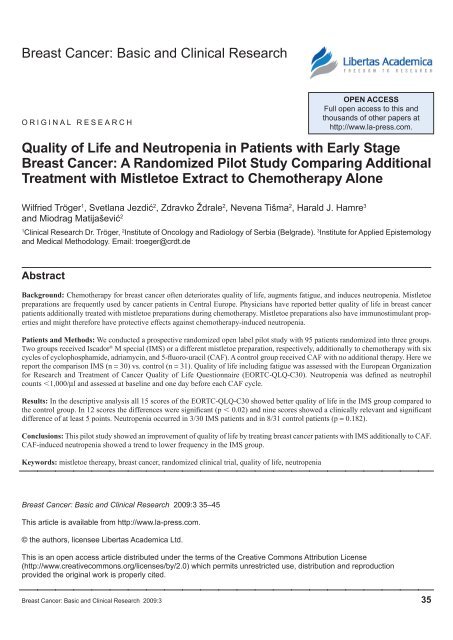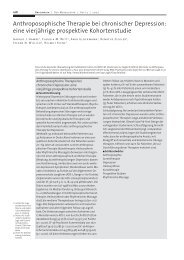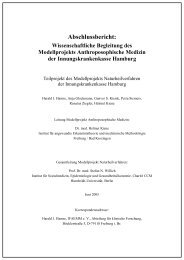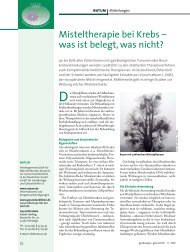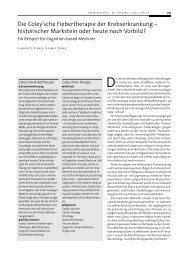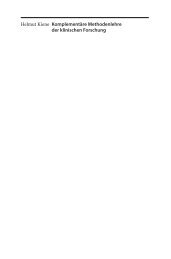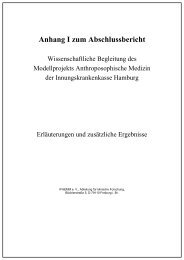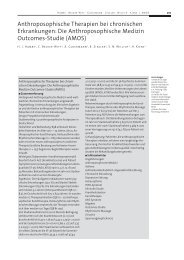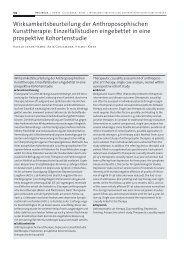Breast Cancer: Basic and Clinical Research Quality of Life and ...
Breast Cancer: Basic and Clinical Research Quality of Life and ...
Breast Cancer: Basic and Clinical Research Quality of Life and ...
You also want an ePaper? Increase the reach of your titles
YUMPU automatically turns print PDFs into web optimized ePapers that Google loves.
<strong>Breast</strong> <strong>Cancer</strong>: <strong>Basic</strong> <strong>and</strong> <strong>Clinical</strong> <strong>Research</strong><br />
O R i g i n A L R e s e A R C h<br />
<strong>Breast</strong> <strong>Cancer</strong>: <strong>Basic</strong> <strong>and</strong> <strong>Clinical</strong> <strong>Research</strong> 2009:3 35–45<br />
This article is available from http://www.la-press.com.<br />
© the authors, licensee Libertas Academica Ltd.<br />
Open Access<br />
Full open access to this <strong>and</strong><br />
thous<strong>and</strong>s <strong>of</strong> other papers at<br />
http://www.la-press.com.<br />
<strong>Quality</strong> <strong>of</strong> <strong>Life</strong> <strong>and</strong> neutropenia in patients with early stage<br />
<strong>Breast</strong> cancer: A R<strong>and</strong>omized pilot study comparing Additional<br />
Treatment with Mistletoe extract to chemotherapy Alone<br />
Wilfried Tröger 1 , Svetlana Jezdić 2 , Zdravko Ždrale 2 , nevena Tišma 2 , harald J. hamre 3<br />
<strong>and</strong> Miodrag Matijašević 2<br />
1 <strong>Clinical</strong> <strong>Research</strong> Dr. Tröger, 2 institute <strong>of</strong> Oncology <strong>and</strong> Radiology <strong>of</strong> serbia (Belgrade). 3 institute for Applied epistemology<br />
<strong>and</strong> Medical Methodology. email: troeger@crdt.de<br />
Abstract<br />
Background: Chemotherapy for breast cancer <strong>of</strong>ten deteriorates quality <strong>of</strong> life, augments fatigue, <strong>and</strong> induces neutropenia. Mistletoe<br />
preparations are frequently used by cancer patients in Central Europe. Physicians have reported better quality <strong>of</strong> life in breast cancer<br />
patients additionally treated with mistletoe preparations during chemotherapy. Mistletoe preparations also have immunostimulant properties<br />
<strong>and</strong> might therefore have protective effects against chemotherapy-induced neutropenia.<br />
Patients <strong>and</strong> Methods: We conducted a prospective r<strong>and</strong>omized open label pilot study with 95 patients r<strong>and</strong>omized into three groups.<br />
Two groups received Iscador ® M special (IMS) or a different mistletoe preparation, respectively, additionally to chemotherapy with six<br />
cycles <strong>of</strong> cyclophosphamide, adriamycin, <strong>and</strong> 5-fluoro-uracil (CAF). A control group received CAF with no additional therapy. Here we<br />
report the comparison IMS (n = 30) vs. control (n = 31). <strong>Quality</strong> <strong>of</strong> life including fatigue was assessed with the European Organization<br />
for <strong>Research</strong> <strong>and</strong> Treatment <strong>of</strong> <strong>Cancer</strong> <strong>Quality</strong> <strong>of</strong> <strong>Life</strong> Questionnaire (EORTC-QLQ-C30). Neutropenia was defined as neutrophil<br />
counts 1,000/µl <strong>and</strong> assessed at baseline <strong>and</strong> one day before each CAF cycle.<br />
Results: In the descriptive analysis all 15 scores <strong>of</strong> the EORTC-QLQ-C30 showed better quality <strong>of</strong> life in the IMS group compared to<br />
the control group. In 12 scores the differences were significant (p 0.02) <strong>and</strong> nine scores showed a clinically relevant <strong>and</strong> significant<br />
difference <strong>of</strong> at least 5 points. Neutropenia occurred in 3/30 IMS patients <strong>and</strong> in 8/31 control patients (p = 0.182).<br />
Conclusions: This pilot study showed an improvement <strong>of</strong> quality <strong>of</strong> life by treating breast cancer patients with IMS additionally to CAF.<br />
CAF-induced neutropenia showed a trend to lower frequency in the IMS group.<br />
Keywords: mistletoe thereapy, breast cancer, r<strong>and</strong>omized clinical trial, quality <strong>of</strong> life, neutropenia<br />
This is an open access article distributed under the terms <strong>of</strong> the Creative Commons Attribution License<br />
(http://www.creativecommons.org/licenses/by/2.0) which permits unrestricted use, distribution <strong>and</strong> reproduction<br />
provided the original work is properly cited.<br />
<strong>Breast</strong> <strong>Cancer</strong>: <strong>Basic</strong> <strong>and</strong> <strong>Clinical</strong> <strong>Research</strong> 2009:3 35
Tröger et al<br />
Introduction<br />
Background<br />
<strong>Quality</strong> <strong>of</strong> life is frequently deteriorated during <strong>and</strong><br />
after chemotherapy for cancer. 1 Besides nausea,<br />
emesis <strong>and</strong> pain, fatigue is a frequent complaint,<br />
reported by 70%–100% <strong>of</strong> the patients. 2 Recent<br />
research has shown that fatigue lasts for months<br />
after the last cycle <strong>of</strong> chemotherapy. 2 Three types<br />
<strong>of</strong> fatigue are distinguished: general, physical,<br />
<strong>and</strong> mental; the latter being related to reduced<br />
activity, depression, anxiety, <strong>and</strong> mood disorders. 3,4<br />
Fatigue, insomnia <strong>and</strong> daytime sleepiness are<br />
augmented during <strong>and</strong> after chemotherapy with<br />
cyclophosphamide <strong>and</strong> 5-FU combined with<br />
methotrexate (CMF) or anthracyclines (CAF). 5<br />
One can conclude that fatigue is one <strong>of</strong> the major<br />
concerns for patients with cancer. 6,7<br />
Mistletoe therapy<br />
Physicians have reported better quality <strong>of</strong> life in breast<br />
cancer patients additionally treated with mistletoe<br />
preparations during chemotherapy, compared to<br />
patients receiving chemotherapy alone. 8–12 Mistletoe<br />
preparations also have immunostimulant <strong>and</strong><br />
DNA-protecting properties 13,14 <strong>and</strong> might therefore<br />
have protective effects against chemotherapy-induced<br />
neutropenia. 15<br />
In Central Europe, mistletoe preparations are<br />
widely used for adjuvant cancer therapy, especially<br />
by breast cancer patients. In Germany, 70% <strong>of</strong><br />
cancer patients use unconventional treatments, <strong>and</strong><br />
r<strong>and</strong>omized trials <strong>of</strong> mistletoe preparations are<br />
difficult to conduct because <strong>of</strong> non-compliance <strong>and</strong><br />
low recruitment rates due to therapy preferences. 16–19<br />
Mistletoe preparations 10,16 as adjunct to CMF 12,16 or<br />
other chemotherapies for breast cancer <strong>and</strong> other<br />
types <strong>of</strong> cancer 10 have been examined in a few clinical<br />
studies showing a benefit in EORTC-QLQ-C30 16 <strong>and</strong><br />
other quality <strong>of</strong> life scores. 10,12<br />
This r<strong>and</strong>omised clinical trial assessed<br />
mistletoe effects during CAF chemotherapy for<br />
breast cancer. The aim was to explore whether<br />
the EORTC-QLQ-C30 is a suitable instrument to<br />
detect differences between patients with early breast<br />
cancer receiving CAF with <strong>and</strong> without additional<br />
mistletoe therapy <strong>and</strong> whether such study is feasible<br />
in Serbia, a country where mistletoe preparations are<br />
not available.<br />
Methods<br />
Objectives<br />
The objectives <strong>of</strong> this pilot study were to determine<br />
the clinical response (quality <strong>of</strong> life including fatigue)<br />
<strong>and</strong> neutropenia in breast cancer patients during<br />
CAF. Our hypotheses were: <strong>Breast</strong> cancer patients<br />
receiving mistletoe preparations during six cycles <strong>of</strong><br />
consecutive treatment with CAF will show a better<br />
quality <strong>of</strong> life including fatigue, <strong>and</strong> less neutropenia<br />
compared to patients receiving CAF alone.<br />
Design<br />
We conducted a prospective r<strong>and</strong>omized open label<br />
study with equal-size r<strong>and</strong>omization into three groups.<br />
All three groups received six cycles <strong>of</strong> CAF. In addition,<br />
one group received Iscador ® M special (IMS), another<br />
group received a different mistletoe preparation <strong>and</strong><br />
a control group had no additional therapy. Here we<br />
report the comparison IMS vs. control.<br />
Participants<br />
<strong>Breast</strong> cancer patients in the stages T 1–3 N 0–2 M 0 treated<br />
at the Institute <strong>of</strong> Oncology <strong>and</strong> Radiology, National<br />
<strong>Cancer</strong> <strong>Research</strong> Centre <strong>of</strong> Serbia in Belgrade (IORS)<br />
<strong>and</strong> prescribed six consecutive cycles <strong>of</strong> CAF after<br />
surgery were assessed for eligibility.<br />
Additional inclusion criteria were female gender,<br />
age 18 years, Karn<strong>of</strong>sky-Index 60, leucocytes<br />
3‚000/mm³, thrombocytes 100‚000/mm³, serum<br />
creatinine 2 mg%, serum glutamic oxaloacetic<br />
transaminase (SGOT), <strong>and</strong> serum glutamic pyruvic<br />
transaminase (SGPT) 2.5 × the upper institutional<br />
limits.<br />
Exclusion criteria were pregnancy or lactation,<br />
metastases, planned radiation or hormone therapy<br />
during six consecutive cycles <strong>of</strong> CAF, use <strong>of</strong><br />
immunostimulant or immunosuppressive agents<br />
(e.g. corticosteroids) except for nausea <strong>and</strong> emesis;<br />
current use <strong>of</strong> other investigational agents, clinically<br />
relevant physical or mental illness such as serious<br />
infections, hepatic, renal or other organ dysfunction<br />
or major depression; alcohol abuse, alcoholism, oral<br />
or parenteral drug abuse, <strong>and</strong> methadone treatment.<br />
R<strong>and</strong>omization<br />
The chance to be allocated to any <strong>of</strong> the three groups<br />
(IMS, other mistletoe preparation, control) was 1:1:1.<br />
36 <strong>Breast</strong> <strong>Cancer</strong>: <strong>Basic</strong> <strong>and</strong> <strong>Clinical</strong> <strong>Research</strong> 2009:3
For r<strong>and</strong>omization variable block sizes were used.<br />
No stratification took place prior to r<strong>and</strong>omization.<br />
The r<strong>and</strong>omization sequence was generated by<br />
<strong>Clinical</strong> <strong>Research</strong> Dr. Tröger (CRDT), using SPSS ®<br />
(SPSS ® 14.0.1, SPSS Inc., Chicago, Ill, USA).<br />
Allocation concealment was implemented by using<br />
sealed envelopes, prepared by CRDT. Patients were<br />
enrolled by investigators at the Outpatient Clinic,<br />
IORS, while the sealed r<strong>and</strong>omization envelopes were<br />
stored in the Department <strong>of</strong> Study Coordination, IORS<br />
<strong>and</strong> released consecutively for each enrolled patient.<br />
interventions<br />
CAF was administered in six cycles with a three-week<br />
interval between each cycle. The scheduled dosage<br />
was 500 mg Cyclophosphamide, 50 mg Adriamycin,<br />
<strong>and</strong> 500 mg 5-FU per 1 m² skin surface applied at<br />
one day. All patients received antiemetic therapy<br />
with a single dose <strong>of</strong> Ondansetrone chloride<br />
8 mg, Dexamethasone 8 mg, <strong>and</strong> Ranitidine 50 mg,<br />
respectively, administered prior to each CAF cycle.<br />
One dropout patient in the control group received<br />
only three CAF cycles, while all other patients received<br />
the six scheduled CAF cycles. The applied dose<br />
intensities (DI) <strong>of</strong> Cyclophosphamide, Adriamycin,<br />
<strong>and</strong> 5-FU (DI in mean mg/m² per week; ± st<strong>and</strong>ard<br />
deviation) were 160.8 ± 5.5 mg, 16.1 ± 0.5 mg, <strong>and</strong><br />
160.8 ± 5.5 mg, respectively, in the IMS group <strong>and</strong><br />
157.1 ± 15.6 mg, 15.7 ± 1.6 mg, <strong>and</strong> 157.1 ± 15.6 mg,<br />
respectively, in the control group. The results<br />
correspond to 99% <strong>of</strong> planned DI in the IMS group<br />
<strong>and</strong> 96% <strong>of</strong> planned DI in the control group. No other<br />
antineoplastic or immunomodulating therapies were<br />
applied during the study.<br />
Patients r<strong>and</strong>omly allocated to additional therapy<br />
with IMS received Iscador ® M special (IMS; fermented<br />
aqueous extract <strong>of</strong> Viscum album from apple tree,<br />
fresh plant material, ratio <strong>of</strong> plant to extract = 1:5).<br />
IMS was manufactured by Weleda AG, Schwäbisch<br />
Gmünd, Germany <strong>and</strong> prepared in 1 ml ampoules<br />
for injection, each ampoule containing the fermented<br />
extract <strong>of</strong> 0.01, 0.1, 1, 2, or 5 mg <strong>of</strong> fresh mistletoe<br />
herb, respectively, in isotonic saline solution. IMS was<br />
administered by subcutaneous injections <strong>of</strong> 1 ml IMS<br />
into the upper abdominal region three times per<br />
week (i.e. Monday, Wednesday, Friday). The patients<br />
were instructed to inject IMS themselves. The<br />
dosage <strong>of</strong> IMS was increased stepwise: 2 × 0.01 mg,<br />
Mistletoe therapy during chemotherapy <strong>of</strong> early breast cancer<br />
2 × 0.1 mg, 11 × 1 mg, 8 × 2 mg, remaining doses<br />
5 mg. Dose-dependent inflammatory reactions at<br />
the injection site (redness, swelling, sometimes<br />
accompanied by itching) were monitored. If such<br />
reactions exceeded 5 cm in diameter, the dosage was<br />
decreased or the therapy was paused until the reactions<br />
had ceased. An average <strong>of</strong> 54.1 ± 2.3 injections with<br />
altogether 174.80 ± 26.34 mg <strong>of</strong> IMS per patient were<br />
administered in the IMS group.<br />
Outcomes<br />
Outcomes were quality <strong>of</strong> life <strong>and</strong> neutropenia. <strong>Quality</strong><br />
<strong>of</strong> life was assessed using the European Organization<br />
for <strong>Research</strong> <strong>and</strong> Treatment <strong>of</strong> <strong>Cancer</strong> <strong>Quality</strong> <strong>of</strong> <strong>Life</strong><br />
Questionnaire (EORTC-QLQ-C30) in the <strong>of</strong>ficial<br />
Serbian translation. 20 The EORTC-QLQ-C30 has<br />
30 questions <strong>and</strong> is analysed in 15 scores: six scores for<br />
functioning <strong>and</strong> nine symptom scores (Table 2). The<br />
EORTC-QLQ-C30 was documented by the patients at<br />
seven visits: before each CAF cycle <strong>and</strong> three weeks<br />
after the 6th CAF cycle. Neutropenia was defined as<br />
neutrophil count 1,000/µl in the peripheral blood<br />
<strong>and</strong> assessed one day before each CAF cycle <strong>and</strong><br />
three weeks after the 6th CAF cycle.<br />
Assessment <strong>of</strong> adverse events (Ae)<br />
Adverse events were assessed by interviewing the<br />
patients <strong>and</strong> by analysing the laboratory results at<br />
each visit. Local reactions to IMS less than 5 cm in<br />
diameter were not considered as adverse events.<br />
sample size<br />
A sample size <strong>of</strong> 90 patients (30 per group) was<br />
considered to be sufficient for this pilot study.<br />
Blinding<br />
The study was not placebo controlled because the<br />
typical <strong>and</strong> time-dependent reactions following<br />
s.c. injections <strong>of</strong> mistletoe extracts (reactions at<br />
the injection site, increased body temperature,<br />
flu-like symptoms) cannot be imitated by a<br />
pseudo-placebo.<br />
statistical methods<br />
Statistical analysis (SPSS ® 14.0) was performed on the<br />
intention-to-treat-population. An alternative analysis<br />
<strong>of</strong> the per-protocol sample, excluding one dropout<br />
patient in the control group, yielded very similar results<br />
<strong>Breast</strong> <strong>Cancer</strong>: <strong>Basic</strong> <strong>and</strong> <strong>Clinical</strong> <strong>Research</strong> 2009:3 37
Tröger et al<br />
(data not shown). All results <strong>of</strong> the statistical analysis<br />
have exclusively hypothesis-generating character.<br />
For each quality <strong>of</strong> life score (EORTC QLQ-C30),<br />
the mean change from baseline during follow-up in<br />
each group was compared between the IMS group,<br />
the group with the other mistletoe preparation <strong>and</strong> the<br />
control group, using nonparametric marginal models<br />
according to Brunner 21 with therapy as whole-plot<br />
factor <strong>and</strong> time as sub-plot factor <strong>and</strong> a possible<br />
interaction between these two factors (results not<br />
shown). As a sensitivity assessment, a parametric<br />
covariance pattern model was also applied <strong>and</strong> found<br />
to qualitatively concur with the nonparametric results.<br />
For a better representability, the estimates <strong>of</strong> this<br />
parametric model will be shown. Post-hoc analyses<br />
<strong>of</strong> differences between the IMS group <strong>and</strong> control<br />
group were performed using the Dunnett T3-Test.<br />
Neutropenia was assessed by measuring the number<br />
<strong>of</strong> patients with neutrophils 1,000/µl during the<br />
study. For neutropenia, the group difference between<br />
IMS group <strong>and</strong> control group was analysed by Fisher’s<br />
exact test according to the sequential rejective Holm<br />
procedure.<br />
Adherence to regulations<br />
The study was approved by the Ethics Committee<br />
<strong>of</strong> the National <strong>Cancer</strong> <strong>Research</strong> Center <strong>of</strong> Serbia<br />
without modifications (date: 3 October 2005) <strong>and</strong> by<br />
the Serbian Drug Agency (date: 01 November 2005).<br />
Due to its pilot character, this study was not registered<br />
in a public study registry. The study was conducted<br />
in compliance with the Declaration <strong>of</strong> Helsinki,<br />
Good <strong>Clinical</strong> Practice guidelines, <strong>and</strong> national laws.<br />
A patient insurance was provided for all participants.<br />
All patients provided signed informed consent prior<br />
to inclusion. CRDT was responsible for planning,<br />
conduct, monitoring, <strong>and</strong> analysis <strong>of</strong> the study.<br />
Two audits at CRDT <strong>and</strong> one at the study site were<br />
performed by the two sponsors during the study.<br />
No violation <strong>of</strong> Good <strong>Clinical</strong> Practice was detected.<br />
Results<br />
Recruitment, participant flow,<br />
assessment, <strong>and</strong> numbers analysed<br />
From 14 December 2005 to 15 February 2007 a total<br />
<strong>of</strong> 123 breast cancer patients were prescribed CAF<br />
<strong>and</strong> assessed for eligibility at the study centre IORS.<br />
28 patients were not included <strong>and</strong> 95 patients were<br />
included <strong>and</strong> r<strong>and</strong>omized into 3 groups: CAF <strong>and</strong><br />
IMS (n = 30), CAF <strong>and</strong> another mistletoe preparation<br />
(n = 34), <strong>and</strong> CAF without additional therapy (n = 31).<br />
One patient in the control group was withdrawn from<br />
further CAF therapy after three cycles <strong>of</strong> CAF because<br />
<strong>of</strong> heart disease (Fig. 1).<br />
The EORTC-QLQ-C30 was evaluable for 99.5%<br />
(209 <strong>of</strong> 210) <strong>of</strong> visits in the IMS group, <strong>and</strong> for<br />
97.2% (211 <strong>of</strong> 217) <strong>of</strong> visits in the control group. The<br />
neutrophil count was assessed at 99.5% (209 <strong>of</strong> 210)<br />
<strong>of</strong> visits in the IMS group <strong>and</strong> 98.2% (213 <strong>of</strong> 217) <strong>of</strong><br />
visits in the control group.<br />
Baseline data <strong>of</strong> the patient groups<br />
The IMS group <strong>and</strong> the control group did not differ<br />
significantly regarding age, tumour stage, body mass<br />
index, physical status, vital signs, previous diseases,<br />
EORTC-QLQ-C30 scores (Table 1). No neutropenia<br />
was detected at baseline.<br />
<strong>Quality</strong> <strong>of</strong> life during chemotherapy<br />
During chemotherapy with CAF a deterioration <strong>of</strong><br />
quality <strong>of</strong> life occurred in all 15 EORTC-QLQ-C30<br />
scores in the control group <strong>and</strong> in six scores in the<br />
IMS group. A clinical relevant deterioration <strong>of</strong> at<br />
least 5 points was found in eight scores <strong>of</strong> the control<br />
group <strong>and</strong> in two scores in the IMS group (Table 3).<br />
The most pronounced deteriorations were observed<br />
for nausea/emesis (17.2 score points) <strong>and</strong> fatigue<br />
(8.2) after the 2nd cycle <strong>of</strong> CAF <strong>and</strong> insomnia (13.1)<br />
<strong>and</strong> diarrhoea (11.9) after the 3rd cycle.<br />
In the adjusted analyses, mean differences from<br />
baseline were compared between the two groups for<br />
each EORTC-QLQ-C30 score: All 15 comparisons<br />
favoured the IMS group, 12 comparisons showed<br />
significant differences with p-values ranging from<br />
0.017 to 0.001. <strong>Clinical</strong>ly relevant differences <strong>of</strong> at<br />
least 5 points favouring the IMS group were observed<br />
for nine EORTC-QLQ-C30 scores (Table 2).<br />
In descriptive analyses, the differences from<br />
baseline for each score at each <strong>of</strong> the six follow-up<br />
assessments were compared between the two groups:<br />
86 out <strong>of</strong> 90 differences favoured the IMS group, while<br />
four differences favoured the control group (Fig. 2).<br />
Furthermore, the maximum between-group difference<br />
for each EORTC-QLQ-C30 score during follow-up<br />
was analysed: All 15 differences favoured the IMS<br />
group: maximum differences <strong>of</strong> at least 15 points<br />
38 <strong>Breast</strong> <strong>Cancer</strong>: <strong>Basic</strong> <strong>and</strong> <strong>Clinical</strong> <strong>Research</strong> 2009:3
R<strong>and</strong>omized<br />
n = 95<br />
Iscador M special<br />
n = 30<br />
completed study<br />
n = 30<br />
Figure 1. Detailed flow chart <strong>of</strong> the patient disposition.<br />
Drop-out<br />
n = 0<br />
were found in four scores (Role Function, Social<br />
Function, Pain, <strong>and</strong> Insomnia), 10–15 point differences<br />
were found in five scores (Global Health, Emotional<br />
function, Constipation, Diarrhoea, Appetite loss), <strong>and</strong><br />
differences 10 points were found in the remaining<br />
six scores.<br />
neutropenia during chemotherapy<br />
Neutropenia (1,000/µl) was detected three times<br />
in three different patients <strong>of</strong> the IMS group <strong>and</strong> nine<br />
times in eight different patients <strong>of</strong> the control group.<br />
The patients with neutropenia are comparable across<br />
the groups (Table 3). Odds ratio for the proportion <strong>of</strong><br />
patients with neutropenia in IMS group vs. control<br />
group was 0.32 (95% confidence interval 0.08–1.35).<br />
Mistletoe therapy during chemotherapy <strong>of</strong> early breast cancer<br />
Assessed for eligibility<br />
n = 123<br />
control<br />
n = 31<br />
not r<strong>and</strong>omized<br />
Reasons for not being r<strong>and</strong>omized:<br />
– no informed consent: n =11<br />
– Failed the eligibility criteria: n = 9<br />
– no study medication available at the<br />
beginning <strong>of</strong> the study: n = 5<br />
– Travel distance: n = 3<br />
completed study<br />
n = 30<br />
Other mistletoe<br />
therapy n = 34<br />
Drop-out<br />
n = 1<br />
Patient has been<br />
withdrawn from<br />
CAF because <strong>of</strong><br />
an heart disease.<br />
Using Fisher’s exact test according to the sequential<br />
rejective Holm procedure, a trend (p = 0.182) towards<br />
less neutropenia in the IMS group was found.<br />
Adverse events related to iMs injections<br />
Localized skin reactions to IMS exceeding 5 cm<br />
diameter occurred in six patients. The frequency <strong>of</strong><br />
these reactions was 0.49% (eight reactions in 1,618<br />
injections). No other adverse events related to IMS<br />
occurred.<br />
Discussion<br />
This r<strong>and</strong>omized pilot study assessed quality <strong>of</strong><br />
life (EORTC-QLQ-C30) <strong>and</strong> neutropenia in early<br />
breast cancer patients undergoing CAF chemotherapy.<br />
<strong>Breast</strong> <strong>Cancer</strong>: <strong>Basic</strong> <strong>and</strong> <strong>Clinical</strong> <strong>Research</strong> 2009:3 39
Tröger et al<br />
Table 1. Baseline status.<br />
Group<br />
IMs (n = 30) control (n = 31) p values<br />
Age in years (mean, ±sD; t-test)<br />
Tumour status (n; Chi square test)<br />
48.4 ± 7.5 50.8 ± 8.0 0.228<br />
Tumour classification 0.879<br />
T1 7 9<br />
T2 21 19<br />
T3 1 2<br />
Tx 1 1<br />
Pos. lymph nodes 0.343<br />
n0 10 16<br />
n1 19 14<br />
n2 1 1<br />
Tumour grade 0.963<br />
g1 1 1<br />
g2 24 24<br />
g3 5 6<br />
Menopause status (n; Kruskal-Wallis test) 0.349<br />
Premenopausal 17 13<br />
Perimenopausal 2 1<br />
Postmenopausal 11 17<br />
Receptor status estrogen 0.714<br />
+ 20 17<br />
- 8 12<br />
Unknown 2 2<br />
Receptor status progesteron 1.000<br />
+ 18 19<br />
- 10 10<br />
Unknown 2 2<br />
Body Mass index (mean, ±sD; t-test) 27.0 ± 6.3 25.6 ± 4.7 0.709<br />
Karn<strong>of</strong>sky-index (mean, ±sD) 100 ± 0.0 100 ± 0.0<br />
Abnormal findings on physical examination (n)<br />
Vital signs (mean, ±sD; t-test)<br />
0 0<br />
Blood pressure systolic mm(hg) 130.0 ± 20.0 132.2 ± 19.0 0.661<br />
Blood pressure diastolic mm(hg) 81.7 ± 12.5 83.6 ± 13.6 0.568<br />
Pulse (/m) 82.3 ± 13.4 77.1 ± 10.1 0.094<br />
Temperature (°C) 36.5 ± 0.1 36.6 ± 0.1 0.268<br />
Previous diseases (n)<br />
Primary endpoints<br />
0 0<br />
neutropenia (n) 0 0<br />
(Continued)<br />
40 <strong>Breast</strong> <strong>Cancer</strong>: <strong>Basic</strong> <strong>and</strong> <strong>Clinical</strong> <strong>Research</strong> 2009:3
Table 1. (Continued)<br />
Mistletoe therapy during chemotherapy <strong>of</strong> early breast cancer<br />
Group<br />
IMs (n = 30) control (n = 31) p values<br />
eORTC-QLQ-C30 (mean, ±sD; Mann-Whitney U-test)<br />
global health status 67.8 ± 20.4 68.5 ± 18.3 0.868<br />
Physical functioning 86.0 ± 14.2 86.0 ± 12.4 0.852<br />
Role functioning 65.5 ± 20.9 73.0 ± 16.9 0.143<br />
emotional functioning 75.8 ± 20.1 74.1 ± 18.1 0.623<br />
Cognitive functioning 85.0 ± 20.7 79.3 ± 23.4 0.267<br />
social functioning 76.7 ± 19.4 80.5 ± 18.9 0.424<br />
Fatigue 22.6 ± 17.2 25.7 ± 19.5 0.593<br />
nausea <strong>and</strong> vomiting 3.4 ± 9.3 2.9 ± 7.8 0.959<br />
Pain 21.7 ± 21.5 16.1 ± 20.6 0.210<br />
Dyspnoea 4.6 ± 14.7 3.4 ± 10.3 0.965<br />
insomnia 16.8 ± 21.1 23.0 ± 31.0 0.557<br />
Appetite loss 12.6 ± 22.6 10.3 ± 20.1 0.625<br />
Constipation 7.8 ± 14.3 6.9 ± 13.7 0.808<br />
Diarrhoea 2.2 ± 8.5 2.3 ± 8.6 0.972<br />
Financial difficulties 23.3 ± 23.4 20.7 ± 30.1 0.358<br />
Patients receiving IMS in addition to CAF had<br />
significantly better quality <strong>of</strong> life <strong>and</strong> showed<br />
a trend towards less neutropenia, compared to<br />
patients receiving CAF alone. IMS therapy was well<br />
tolerated.<br />
Strengths <strong>of</strong> this study include a high recruitment<br />
rate, detailed assessments <strong>of</strong> therapy implementation,<br />
high therapy compliance, <strong>and</strong> very low dropout<br />
rates. Since 83% <strong>of</strong> eligible patients were included<br />
<strong>and</strong> r<strong>and</strong>omized, the results <strong>of</strong> this study would<br />
seem to be generalizable to breast cancer patients<br />
(T 1–3 N 0–2 M 0 ) receiving CAF without any other<br />
concomitant therapies.<br />
Due to the open-label design, the study cannot<br />
distinguish between direct drug effects on quality<br />
<strong>of</strong> life <strong>and</strong> possible indirect effects from therapy<br />
expectations, therapy administration etc. in the IMS<br />
group. This is a general limitation to all mistletoe<br />
studies: mistletoe injections frequently cause<br />
local reactions at the injection site, elevated body<br />
temperature <strong>and</strong> flu-like symptoms. These symptoms<br />
cease within hours or days after exposure <strong>and</strong> may<br />
recur on repeated injections. Therefore, patients <strong>and</strong><br />
physicians can easily guess if mistletoe extracts are<br />
administered. This was confirmed in a double-blind<br />
study, where all patients in the mistletoe group as<br />
well as their physicians were unblinded. 16 A pseudoplacebo<br />
causing the same combination <strong>of</strong> time-limited<br />
symptoms—without specific effects on quality <strong>of</strong><br />
life—has not yet been constructed.<br />
Generally, medication trials are blinded to separate<br />
pharmacological effects from placebo effects.<br />
However, the lack <strong>of</strong> blinding may not necessarily<br />
have had relevant effects on the results <strong>of</strong> this<br />
study: An updated Cochrane review <strong>of</strong> r<strong>and</strong>omised<br />
trials comparing placebo to no treatment found no<br />
significant placebo effects on eight out <strong>of</strong> ten evaluable<br />
indications, small effects on self-reported pain <strong>and</strong><br />
moderate effects on phobia. Even these effects might<br />
have been confounded by biases. 22–24<br />
This study was designed as a pilot study, <strong>and</strong> the<br />
limited sample size <strong>of</strong> 30 patients per group does<br />
not allow for hypothesis confirmation. Nevertheless<br />
significant differences in 12 <strong>of</strong> 15 EORTC-QLQ-C30<br />
scores favouring the IMS group were found. Nine <strong>of</strong><br />
these scores showed a clinically relevant difference<br />
<strong>of</strong> at least 5 points. The latter scores include pain,<br />
nausea, emesis <strong>and</strong> insomnia, which are highly<br />
relevant symptoms in patients during chemotherapy<br />
with CAF.<br />
<strong>Breast</strong> <strong>Cancer</strong>: <strong>Basic</strong> <strong>and</strong> <strong>Clinical</strong> <strong>Research</strong> 2009:3 41
Tröger et al<br />
Table 2. eORTC QLQ-C30 scores: mean change from baseline.<br />
eORTc QLQ-c30 score Mean change from baseline<br />
<strong>Quality</strong> <strong>of</strong> life IMs (n = 30) control (n = 31) Difference 95% Confidence interval p-value<br />
global health status 2.77 -0.15 2.92 -2.15 to 7.98 0.393<br />
Physical functioning -0.52 -4.08 3.56 0.61 to 6.51 0.014*<br />
Role functioning 12.88 -1.21 14.09 9.02 to 19.16 0.001*<br />
emotional functioning 3.73 -2.62 6.35 2.15 to 10.54 0.001*<br />
Cognitive functioning 1.81 -2.28 4.10 -0.33 to 8.53 0.076<br />
social functioning 2.08 -5.66 7.74 3.37 to 12.12 0.001*<br />
Fatigue 0.93 5.84 -4.92 -8.78 to -1.05 0.009*<br />
nausea <strong>and</strong> vomiting 7.02 14.60 -7.58 -12.25 to -2.91 0.001*<br />
Pain -9.81 2.66 -12.47 -16.85 to -8.08 0.001*<br />
Dyspnoea -2.32 1.38 -3.70 -6.79 to -0.60 0.015*<br />
insomnia -2.53 5.72 -8.25 -13.42 to -3.09 0.001*<br />
Appetite loss -1.35 5.30 -6.64 -12.28 to -1.01 0.017*<br />
Constipation 7.21 8.33 -1.12 -6.53 to 4.29 1.000<br />
Diarrhoea 0.16 6.27 -6.11 -9.47 to -2.75 0.001*<br />
Financial difficulties 2.10 11.04 -8.94 -14.21 to -3.67 0.001*<br />
Difference <strong>of</strong> the mean <strong>of</strong> all six follow-up assessments from the baseline: better quality <strong>of</strong> life is indicated by higher values in the first six scores <strong>and</strong> by<br />
lower scores in the following nine symptom scores.<br />
*Significant difference in the post hoc Dunnett test.<br />
Table 3. List <strong>of</strong> patients experiencing a neutropenia during CAF.<br />
Group ID Visit no. Date (Visit) Age stage T n M G Leucocytes/nl neutrophils/nl<br />
iMs 37 7 20/10/2006 60 2 2 1 0 2 2.9 0.9<br />
44 7 03/11/2006 44 2 3 1 0 2 1.8 0.4<br />
60 2 18/09/2006 51 2 1 0 0 2 6.7 0.6<br />
Control 13 3 26/04/2006 32 2 2 1 0 2 2.8 0.9<br />
33 5 29/08/2006 60 2 2 0 0 2 2.4 0.9<br />
51 7 08/12/2006 66 2 2 1 0 2 1.3 0.3<br />
56 7 21/12/2006 53 2 2 1 0 2 3.5 0.9<br />
62 7 31/01/2007 62 2 1 1 0 2 2.5 0.8<br />
66 7 23/01/2007 44 1 1 0 0 2 2.4 0.8<br />
87 6 26/03/2007 45 2 2 1 0 2 3.3 0.3<br />
90 6 29/03/2007 52 2 1 0 0 3 2.6 0.8<br />
90 7 19/04/2007 52 2 1 0 0 3 2.7 0.9<br />
Three patients <strong>of</strong> the iMs group <strong>and</strong> eight patients <strong>of</strong> the control group. experienced a neutropenia (p = 0.182; 2-sided Fishers exact test).<br />
42 <strong>Breast</strong> <strong>Cancer</strong>: <strong>Basic</strong> <strong>and</strong> <strong>Clinical</strong> <strong>Research</strong> 2009:3
eORTc score (means; ± sD)<br />
30<br />
20<br />
10<br />
0<br />
−10<br />
−20<br />
−30<br />
Global Health status<br />
Visit: 1 2 3 4 5 6 7<br />
eORTc score (means; ± sD)<br />
40<br />
30<br />
20<br />
10<br />
0<br />
−10<br />
−20<br />
−30<br />
Role Function<br />
Visit: 1 2 3 4 5 6 7<br />
eORTc score (means; ± sD)<br />
30<br />
20<br />
10<br />
0<br />
−10<br />
−20<br />
−30<br />
cognitive Function<br />
Visit: 1 2 3 4 5 6 7<br />
eORTc score (means; ± sD)<br />
40<br />
30<br />
20<br />
10<br />
0<br />
−10<br />
−20<br />
−30<br />
eORTc score (means; ± sD)<br />
10<br />
0<br />
−10<br />
−20<br />
physical Function<br />
Visit: 1 2 3 4 5 6 7<br />
eORTc score (means; ± sD)<br />
30<br />
20<br />
10<br />
0<br />
−10<br />
−20<br />
−30<br />
emotional Function<br />
Visit: 1 2 3 4 5 6 7<br />
eORTc score (means; ± sD)<br />
25<br />
5<br />
−5<br />
−15<br />
−25<br />
−35<br />
social Function<br />
Visit: 1 2 3 4 5 6 7<br />
constipation<br />
Visit: 1 2 3 4 5 6 7<br />
eORTc score (means; ± sD)<br />
35<br />
25<br />
15<br />
5<br />
−5<br />
−15<br />
Mistletoe therapy during chemotherapy <strong>of</strong> early breast cancer<br />
Diarrhoea<br />
Visit: 1 2 3 4 5 6 7<br />
Figure 2. Graphs <strong>of</strong> the 15 scores <strong>of</strong> the EORTC-QLQ-C30. The filled markers represent the iMs group whereas the empty squares represent the<br />
control group. The mean difference from baseline <strong>of</strong> the eORTC score (mean; ± sD) is displayed for each visit. in the 6 function scores a higher qualtiy <strong>of</strong><br />
life is represented by higher values. in the 9 symptom scores a higher quality <strong>of</strong> life is represented by lower values.<br />
An important problem which may occur during<br />
chemotherapy with CAF is neutropenia. Neutropenia<br />
is the limiting factor for a continuing chemotherapy<br />
<strong>and</strong> may be harmful to the patients. This study is the<br />
first r<strong>and</strong>omized trial providing data on the incidence<br />
<strong>of</strong> CAF-induced neutropenia during additive therapy<br />
with IMS. A trend towards less neutropenia in the IMS<br />
<strong>Breast</strong> <strong>Cancer</strong>: <strong>Basic</strong> <strong>and</strong> <strong>Clinical</strong> <strong>Research</strong> 2009:3 43<br />
eORTc score (means; ± sD)<br />
25<br />
20<br />
15<br />
10<br />
5<br />
0<br />
−5<br />
−10<br />
−15<br />
−20<br />
Visit: 1 2 3 4 5 6 7<br />
eORTc score (means; ± sD)<br />
25<br />
15<br />
5<br />
−5<br />
−15<br />
−25<br />
−35<br />
eORTc score (means; ± sD)<br />
40<br />
30<br />
20<br />
10<br />
0<br />
−10<br />
−20<br />
Fatigue<br />
Visit: 1 2 3 4 5 6 7<br />
eORTc score (means; ± sD)<br />
40<br />
30<br />
20<br />
10<br />
0<br />
−10<br />
−20<br />
−30<br />
pain<br />
Insomnia<br />
Visit: 1 2 3 4 5 6 7<br />
Financial problems<br />
eORTc score (means; ± sD)<br />
−15<br />
Visit: 1 2 3 4 5 6 7<br />
45<br />
35<br />
25<br />
15<br />
5<br />
−5<br />
nausea/emesis<br />
Visit: 1 2 3 4 5 6 7<br />
eORTc score (means; ± sD)<br />
20<br />
10<br />
0<br />
−10<br />
−20<br />
Dyspnoea<br />
Visit: 1 2 3 4 5 6 7<br />
eORTc score (means; ± sD)<br />
40<br />
30<br />
20<br />
10<br />
0<br />
−10<br />
−20<br />
−30<br />
Appetite Loss<br />
Visit: 1 2 3 4 5 6 7<br />
group was found. This should be further investigated<br />
in confirmatory studies with adequate sample size. It is<br />
recommended to include measurements <strong>of</strong> neutrophils<br />
on day 7, 9 <strong>and</strong> day 11 after chemotherapy in order to<br />
assess the nadir <strong>of</strong> the neutropenia during CAF therapy.<br />
Future studies <strong>of</strong> mistletoe effects on quality <strong>of</strong><br />
life in cancer patients undergoing chemotherapy
Tröger et al<br />
should also include specific instruments to assess<br />
cancer-related fatigue <strong>and</strong> pain. In our study the<br />
effects <strong>of</strong> IMS on quality <strong>of</strong> life increased over time<br />
with the largest effects observed at the last follow-up<br />
visit. A longer follow-up period <strong>of</strong> 6–12 months might<br />
show additional long term benefits <strong>of</strong> IMS therapy.<br />
conclusions<br />
In this r<strong>and</strong>omized pilot study, additional treatment<br />
with mistletoe therapy (Iscador ® M special) improved<br />
quality <strong>of</strong> life <strong>and</strong> showed a trend towards reduction<br />
<strong>of</strong> neutropenia in patients with early breast cancer<br />
receiving CAF chemotherapy. These promising<br />
results should be confirmed in a larger study.<br />
Abbreviations<br />
CAF, cyclophosphamide; adriamycin, <strong>and</strong> 5-fluoro-<br />
uracil; CRDT, <strong>Clinical</strong> <strong>Research</strong> Dr. Tröger; DI, dose<br />
intensity; EORTC-QLQ-C30, European Organization<br />
for <strong>Research</strong> <strong>and</strong> Treatment <strong>of</strong> <strong>Cancer</strong> <strong>Quality</strong> <strong>of</strong><br />
<strong>Life</strong> Questionnaire; IMS, Iscador ® M special; IORS,<br />
Institute <strong>of</strong> Oncology <strong>and</strong> Radiology; National <strong>Cancer</strong><br />
<strong>Research</strong> Centre <strong>of</strong> Serbia in Belgrade.<br />
competing Interests<br />
The part <strong>of</strong> the study that is reported here was<br />
financially supported by the Society for <strong>Cancer</strong><br />
<strong>Research</strong>, Arlesheim, Switzerl<strong>and</strong>. The sponsor had<br />
no influence on study design, planning, conduct<br />
or analysis. The authors declare that they have no<br />
conflict <strong>of</strong> interest.<br />
Authors’ contributions<br />
MM was the responsible principal investigator.<br />
SJ <strong>and</strong> ZZ were investigators. NT carried out<br />
the blood analysis. HJH was medical advisor<br />
<strong>and</strong> contributed to manuscript revision. WT was<br />
principal author <strong>of</strong> the paper, wrote the study<br />
protocol, coordinated the study, had full access<br />
to all data, <strong>and</strong> is guarantor. All authors read <strong>and</strong><br />
approved the final manuscript.<br />
Acknowledgements<br />
The authors would like to thank Petra Siemers, Anja<br />
Glockmann, <strong>and</strong> Claudia Bihl for monitoring <strong>and</strong><br />
data management, Biostatistik Fischer for statistical<br />
analyses, <strong>and</strong> Dušanka Jelecanin for the coordination<br />
<strong>of</strong> the patients on site. Special thanks go to the study<br />
nurses Milijana Sokol <strong>and</strong> Zorica R<strong>and</strong>elović <strong>and</strong> the<br />
participating patients.<br />
References<br />
1. Ganz PA, Kwan L, Stanton AL, et al. <strong>Quality</strong> <strong>of</strong> life at the end <strong>of</strong> primary<br />
treatment <strong>of</strong> breast cancer: first results from the moving beyond cancer<br />
r<strong>and</strong>omized trial. J Natl <strong>Cancer</strong> Inst. 2004 March 3;96(5):376–87.<br />
2. de Jong N, C<strong>and</strong>el MJ, Schouten HC, Abu-Saad HH, Courtens AM.<br />
Prevalence <strong>and</strong> course <strong>of</strong> fatigue in breast cancer patients receiving adjuvant<br />
chemotherapy. Ann Oncol. 2004 June;15(6):896–905.<br />
3. de Jong N, C<strong>and</strong>el MJ, Schouten HC, Abu-Saad HH, Courtens AM. Course<br />
<strong>of</strong> mental fatigue <strong>and</strong> motivation in breast cancer patients receiving adjuvant<br />
chemotherapy. Ann Oncol. 2005 March;16(3):372–82.<br />
4. Goldstein D, Bennett B, Friedl<strong>and</strong>er M, Davenport T, Hickie I, Lloyd A.<br />
Fatigue states after cancer treatment occur both in association with, <strong>and</strong><br />
independent <strong>of</strong>, mood disorder: a longitudinal study. BMC <strong>Cancer</strong>. 2006<br />
October 9;6:240.<br />
5. Kuo HH, Chiu MJ, Liao WC, Hwang SL. <strong>Quality</strong> <strong>of</strong> sleep <strong>and</strong> related factors<br />
during chemotherapy in patients with stage I/II breast cancer. J Formos Med<br />
Assoc. 2006 January;105(1):64–9.<br />
6. Butt Z, Rosenbloom SK, Abernethy AP, et al. Fatigue is the most important<br />
symptom for advanced cancer patients who have had chemotherapy. J Natl<br />
Compr Canc Netw. 2008 May;6(5):448–55.<br />
7. Mock V, Atkinson A, Barsevick A, et al. NCCN Practice Guidelines for<br />
<strong>Cancer</strong>-Related Fatigue. Oncology (Williston Park). 2000 November;<br />
14(11A):151–61.<br />
8. Heiny BM. Additive Therapie mit st<strong>and</strong>ardisiertem Mistelextrakt reduziert<br />
die Leukopenie und verbessert die Lebensqualität von Patientinnen mit<br />
fortgeschrittenem Mammakarzinom unter palliativer Chemotherapie<br />
(VEC-Schema). Krebsmedizin. 1991;12(Sonderdruck):1–14.<br />
9. Heusser P, Braun SB, Ziegler R, et al. Palliative in-patient cancer treatment<br />
in an anthroposophic hospital: I. Treatment patterns <strong>and</strong> compliance<br />
with anthroposophic medicine. Forsch Komplementarmed. 2006 April;<br />
13(2):94–100.<br />
10. Piao BK, Wang YX, Xie GR, et al. Impact <strong>of</strong> complementary mistletoe<br />
extract treatment on quality <strong>of</strong> life in breast, ovarian <strong>and</strong> non-small cell<br />
lung cancer patients. A prospective r<strong>and</strong>omized controlled clinical trial.<br />
Anticancer Res. 2004 January;24(1):303–9.<br />
11. Semiglasov VF, Stepula VV, Dudov A, Lehmacher W, Mengs U. The<br />
st<strong>and</strong>ardised mistletoe extract PS76A2 improves QoL in patients with breast<br />
cancer receiving adjuvant CMF chemotherapy: a r<strong>and</strong>omised, placebocontrolled,<br />
double-blind, multicentre clinical trial. Anticancer Res. 2004<br />
March;24(2C):1293–302.<br />
12. Semiglazov VF, Stepula VV, Dudov A, Schnitker J, Mengs U. <strong>Quality</strong><br />
<strong>of</strong> life is improved in breast cancer patients by St<strong>and</strong>ardised Mistletoe<br />
Extract PS76A2 during chemotherapy <strong>and</strong> follow-up: a r<strong>and</strong>omised,<br />
placebo-controlled, double-blind, multicentre clinical trial. Anticancer Res.<br />
2006 March;26(2B):1519–29.<br />
13. Büssing A, Schietzel M, Regnery A, Schweizer K. The dual role <strong>of</strong> Viscum<br />
album L. effects: cytostatic <strong>and</strong> DNA stabilizing properties. Eur J Allerg<br />
Clin Immun. 1995;26:9.<br />
14. Büssing A, Regnery A, Schweizer K. Effects <strong>of</strong> Viscum album L. on<br />
cyclophosphamide-treated peripheral blood mononuclear cells in vitro:<br />
sister chromatid exchanges <strong>and</strong> activation/proliferation marker expression.<br />
<strong>Cancer</strong> Lett. 1995 August 1;94(2):199–205.<br />
15. Büssing A, Jurin M, Zarkovic N, Azhari T, Schweizer K. DNA-stabilisierende<br />
Wirkungen von Viscum album L.—Sind Mistelextrakte als Adjuvans während<br />
der konventionellen Chemotherapie indiziert? Forsch Komplementärmed<br />
Klass Naturheilkd. 1996;3:244–8.<br />
16. Auerbach L, Dostal V, Václavik-Fleck I, et al. Signifikant höherer<br />
Anteil aktivierter NK-Zellen durch additive Misteltherapie bei<br />
chemotherapierten Mamma-CA-Patientinnen in einer prospektiven<br />
r<strong>and</strong>omisierten doppelblinden Studie. In: Scheer R, Bauer R,<br />
Becker H, Fintelmann V, Kemper FH, Schilcher H, editors. Fortschritte<br />
in der Misteltherapie. Aktueller St<strong>and</strong> der Forschung und klinischen<br />
Anwendung. Essen: KCV Verlag; 2005. p. 543–54.<br />
44 <strong>Breast</strong> <strong>Cancer</strong>: <strong>Basic</strong> <strong>and</strong> <strong>Clinical</strong> <strong>Research</strong> 2009:3
17. Gerhard I. Problems <strong>of</strong> r<strong>and</strong>omised treatment studies in complementary<br />
medicine. Forschende Komplementärmedizin 7, 34–35. 2000. Ref Type:<br />
Abstract.<br />
18. Rostock M, Huber R. R<strong>and</strong>omized <strong>and</strong> double-blind studies—dem<strong>and</strong>s<br />
<strong>and</strong> reality as demonstrated by two examples <strong>of</strong> mistletoe research. Forsch<br />
Komplementarmed Klass Naturheilkd. 2004 August;11(Suppl.1):18–22.<br />
19. Ziegler R. Mistletoe Preparation Iscador: Are there Methodological Concerns<br />
with Respect to Controlled <strong>Clinical</strong> Trials? Evid Based Complement<br />
Alternat Med. 2007 October 4; Open Access Article, doi:10.1093/ecam/<br />
nem121:1–12. Available at: URL: PM:18955241.<br />
20. Aaronson NK, Ahmedzai S, Bergman B, et al. The European Organization<br />
for <strong>Research</strong> <strong>and</strong> Treatment <strong>of</strong> <strong>Cancer</strong> QLQ-C30: a quality-<strong>of</strong>-life instrument<br />
for use in international clinical trials in oncology. J Natl <strong>Cancer</strong> Inst. 1993<br />
March 3;85(5):365–76.<br />
Mistletoe therapy during chemotherapy <strong>of</strong> early breast cancer<br />
21. Brunner E, Langer F. Nichtparametrische Analyse longitudinaler Daten.<br />
München: Oldenbourg Verlag; 1999.<br />
22. Hrobjartsson A, Gotzsche PC. Is the placebo powerless? An analysis <strong>of</strong><br />
clinical trials comparing placebo with no treatment. N Engl J Med. 2001<br />
May 24;344(21):1594–602.<br />
23. Hrobjartsson A, Gotzsche PC. Is the placebo powerless? Update <strong>of</strong> a<br />
systematic review with 52 new r<strong>and</strong>omized trials comparing placebo with<br />
no treatment. J Intern Med. 2004 August;256(2):91–100.<br />
24. Hrobjartsson A, Gotzsche PC. Placebo interventions for all clinical<br />
conditions. Cochrane Database Syst Rev. 2004;(3):CD003974.<br />
publish with Libertas Academica <strong>and</strong><br />
every scientist working in your field can<br />
read your article<br />
“I would like to say that this is the most author-friendly<br />
editing process I have experienced in over 150<br />
publications. Thank you most sincerely.”<br />
“The communication between your staff <strong>and</strong> me has<br />
been terrific. Whenever progress is made with the<br />
manuscript, I receive notice. Quite honestly, I’ve<br />
never had such complete communication with a<br />
journal.”<br />
“LA is different, <strong>and</strong> hopefully represents a kind <strong>of</strong><br />
scientific publication machinery that removes the<br />
hurdles from free flow <strong>of</strong> scientific thought.”<br />
Your paper will be:<br />
• Available to your entire community<br />
free <strong>of</strong> charge<br />
• Fairly <strong>and</strong> quickly peer reviewed<br />
• Yours! You retain copyright<br />
http://www.la-press.com<br />
<strong>Breast</strong> <strong>Cancer</strong>: <strong>Basic</strong> <strong>and</strong> <strong>Clinical</strong> <strong>Research</strong> 2009:3 45


